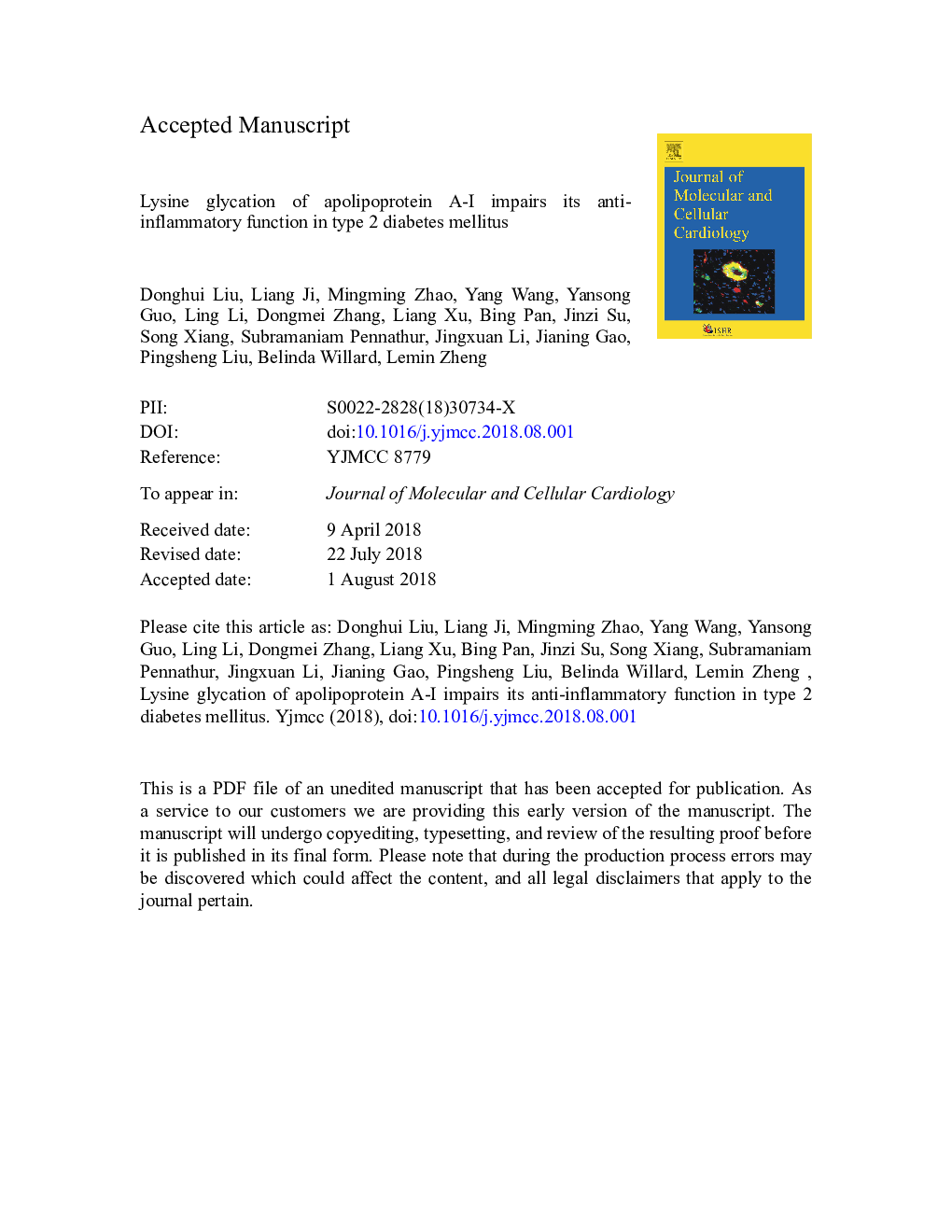| کد مقاله | کد نشریه | سال انتشار | مقاله انگلیسی | نسخه تمام متن |
|---|---|---|---|---|
| 8473092 | 1550383 | 2018 | 43 صفحه PDF | دانلود رایگان |
عنوان انگلیسی مقاله ISI
Lysine glycation of apolipoprotein A-I impairs its anti-inflammatory function in type 2 diabetes mellitus
دانلود مقاله + سفارش ترجمه
دانلود مقاله ISI انگلیسی
رایگان برای ایرانیان
کلمات کلیدی
T2DMLPSRCTApoA-ICIDABCA1HDLhigh-density lipoprotein - HDL یا لیپوپروتئین با دانسیته بالا یا چگالی بالاapolipoprotein - آپولیپوپروتئینApolipoprotein A-I - آپولیپوپروتئین A-Iglutamic acid - اسید گلوتامیکinflammation - التهاب( توروم) cardiovascular disease - بیماری قلب و عروقیcollision induced dissociation - تقارن ناشی از برخوردType 2 diabetes mellitus - دیابت نوع دوCVD - رسوب دهی شیمیایی بخار Lysine - لیزینlipopolysaccharide - لیپوپلی ساکاریدProteomics - پروتئومیکسreverse cholesterol transport - کلسترول معکوس حمل و نقلGlycation - گلیکاسیون، گلیکیشن، گلایکیشن
موضوعات مرتبط
علوم زیستی و بیوفناوری
بیوشیمی، ژنتیک و زیست شناسی مولکولی
بیولوژی سلول
پیش نمایش صفحه اول مقاله

چکیده انگلیسی
Apolipoprotein A-I (apoA-I), the major protein compontent of high-density lipoprotein (HDL), exerts many anti-atherogenic functions. This study aimed to reveal whether nonenzymatic glycation of specific sites of apoA-I impaired its anti-inflammatory effects in type 2 diabetes mellitus (T2DM). LC-MS/MS was used to analyze the specific sites and the extent of apoA-I glycation either modified by glucose in vitro or isolated from T2DM patients. Cytokine release in THP-1 monocyte-derived macrophages was tested by ELISA. Activation of NF-kappa B pathway was detected by western blot. The binding affinity of apoA-I to THP-1 cells was measured using 125I-labeled apoA-I. We identified seven specific lysine (Lys, K) residues of apoA-I (K12, K23, K40, K96, K106, K107 and K238) that were susceptible to be glycated either in vitro or in vivo. Glycation of apoA-I impaired its abilities to inhibit the release of TNF-α and IL-1β against lipopolysaccharide (LPS) in THP-1 cells. Besides, the glycation levels of these seven K sites in apoA-I were inversely correlated with its anti-inflammatory abilities. Furthermore, glycated apoA-I had a lower affinity to THP-1 cells than native apoA-I had. We generated mutant apoA-I (K107E, M-apoA-I) with a substitution of glutamic acid (Glu, E) for lysine at the 107th site, and found that compared to wild type apoA-I (WT-apoA-I), M-apoA-I decreased its anti-inflammatory effects in THP-1 cells. We also modeled the location of these seven K residues on apoA-I which allowed us to infer the conformational alteration of glycated apoA-I and HDL. In summary, glycation of these seven K residues altered the conformation of apoA-I and consequently impaired the protective effects of apoA-I, which may partly account for the increased risk of cardiovascular disease (CVD) in diabetic subjects.
ناشر
Database: Elsevier - ScienceDirect (ساینس دایرکت)
Journal: Journal of Molecular and Cellular Cardiology - Volume 122, September 2018, Pages 47-57
Journal: Journal of Molecular and Cellular Cardiology - Volume 122, September 2018, Pages 47-57
نویسندگان
Donghui Liu, Liang Ji, Mingming Zhao, Yang Wang, Yansong Guo, Ling Li, Dongmei Zhang, Liang Xu, Bing Pan, Jinzi Su, Song Xiang, Subramaniam Pennathur, Jingxuan Li, Jianing Gao, Pingsheng Liu, Belinda Willard, Lemin Zheng,